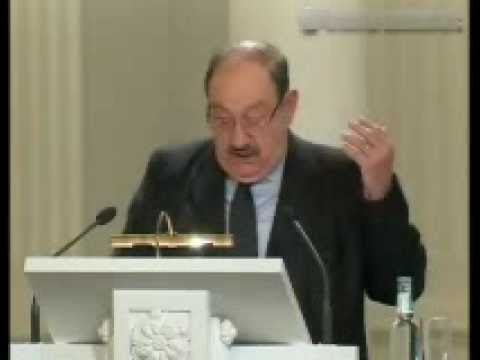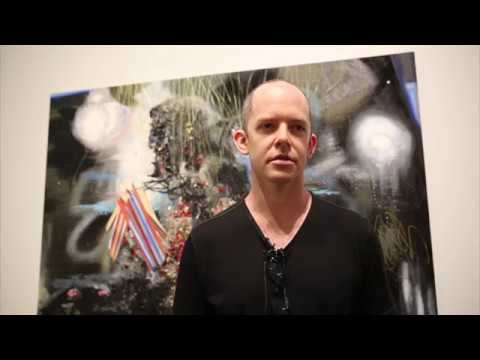Dionnis1
On May 6, 2009, Umberto Eco received an honorary doctorate in philosophy at Tartu University, Estonia. Following the doctoral receipt protocol, he held a public course called “On the Ontology of Fictional Characters: a Semiotic Study”. The movie is taken from the university site.
Umberto Eco – “On the Ontology of Fictional Characters: A Semiotic Study” (1-2)




Well, he gives a talk in Estonia, and the guys from the Baltic countries thought it was fair enough to fight for their independence from USSR within the German army ranks. Many atrocities committed by SS troops were actually done by the "legionaries" from Latvia and Estonia. Hence the prank joke 🙂
Platonic semiotics
A completely new subjective semiotics based on the metaphysics of Plato-Leibniz instead of the objective model of C S Peirce.
The purpose of this note is to demonstrate the advantages of using a semiotic based on the ,metaphysics of Plato and Leibniz, which is subjective, in contrast to Peirce's objective semiotics. This allows a more complete understanding of the semiotic triad and greatly expands its range of applications into the mental realm, including thinking and the bicameral mind.
We are faced with a situation similar to that faced by Kant in his model of transcendental perception,
in which there is a physical realm and a mental one. At the same time, by transcendental Kant meant transcendent to an individual's mind. Here the transcendence goes beyond the individual's mind to Plato's Mind (the One).
There are two ways to proceed. The first, ftrom Peirce, is entirely empirical, going from an object to an observer. The second, employing the metaphysics of Plato combined with Leibniz, goes in the opposite direction, starting with Plato's Mind (the One) and extending either to a physical object, as represdented by a monad in perception, or to a completely mental object in thinking or just awareness.
To begin with, Peirce's Firstness (P1)is the physical object, his Secondness (P2) is the sign, and his Thirdness (P3) is the interprant. A disadvantage of using Peirce's semiotics is that Peirce used only an objective, non-psychological interprant, which is understable since Peirce was essentially a logician. The Peirce model is essenttially empirical.So in Peirce, the causation is from Object to Sign to Interprant
In contrast, in Plato-Leibniz (PL), all creation, control and perception is top down from Mind (the One). Mind creates all, perceives all,
and controls all. Thus mind controls the brain, the brain does not create and control mind as in contemporary neuroscience.
Instead, mind plays the brain like a violin.
Thus Mind is the ultimate interprant and it creates the sign-object, which is a dual, moderated by Mind.
For a solid physical object, the interprant creates and moderates the sign-object, which Leibniz calls a monad.
But it can also deal with thoughts and perceptions through the use of intendeds, which are intended mental objects (Secondnesses).
Thus according to the PL model, in perceiving a physical object, causation begins with Mind and goes down through
some mental levels . to the bottom in the right bicameral brain, where an input physical sensory signal is converted by
Mind into a mental experience.
If thinking rather than perception is the task at hand, in the PL model, causation begins with Mind and goes down through some
mental levels but only in the left bicameral brain to the bottom where attention is given to either an intuition in Mind or a in the
right bicameral brain, where an input physical sensory signal is converted by Mind into a mental experience.
Tentative level of consciousness starting with 1, the highest level (in Mind)
1.Reapperceptions (Intended apperceptions (conscious thoughts, ideas))
() left bicameral brain
2. Apperceptions (Intended perceptions (conscious perceptions)
() left and right bicameral brain
3. Perceptions (unconscious sensory perceptions)
() right bicameral brain
4. Mental Sign (monad)
() right bicameral brain
5. Physical Object
In Plato-Leibniz, for perception of physical object:
1 is thoughts and ideas (PL Firstness or PL1)
2. is conscious perceptioms (PL Conscious Secondness PL2C
3. is raw perception of image of object (PL Unconscious Secondness PL2U)
4. is monad or sign of object as image ( (PL indicator Secondness PL2U)
5. Physical Object
In Plato-Leibniz, for thinking
1 is thoughts and ideas (PL Firstness or PL1)
2. is intended conscious idea (PL Conscious Secondness PL2C
3. is unintended unconscious idea in memory (PL Unconscious Secondness PL2M)
In Peirce:
3 is interprant (Peirce Thirdness or P3)
4. is sign (Peirce Secondess or P2)
5 is object (Peirce Firstness of P1))
The PL model gives us a basis to discuss any mental operation, including perception and thinking or simple
awareness, includes memory, and allows a futher basis for discussing the process of thinking.
—
Dr. Roger B Clough NIST (retired, 2000).
See my Leibniz site: https://rclough@verizon.academia.edu/RogerClough
For personal messages use rclough@verizon.net
So many people struggling to keep their eyes open